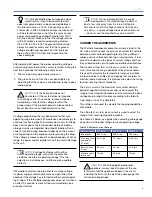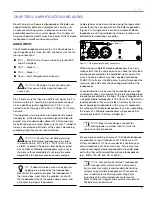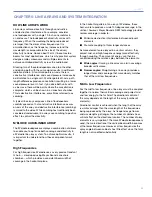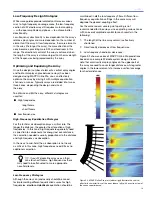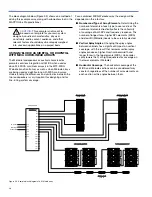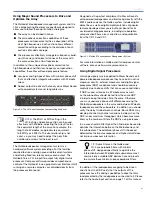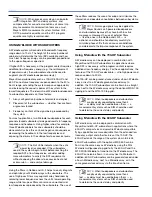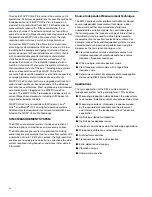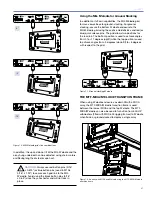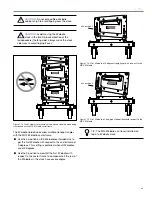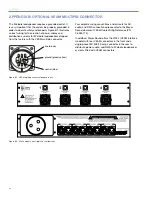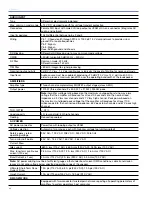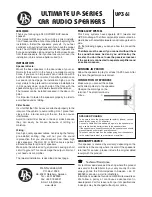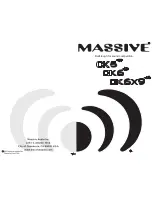
22
CHAPTER 5
NOTE:
When precise array design, subwoofer
integration, DSP and delay systems, and
compensation for acoustical conditions all come into
play, measurement and correction tools are a must.
Meyer’s SIM 3 measurement system, Galileo, LD-3,
CP-10 parametric equalizer and the VX-1 program
equalizer are highly recommended.
USING M’ELODIE WITH SUBWOOFERS
A M’elodie system will provide full bandwidth frequency
range down to 70 Hz. The height of the array (number of
cabinets) will determine the total SPL available and how
much low frequency energy can be provided, proportional
to the upper-frequency spectrum.
If higher SPL is necessary, or the program content requires
additional low-frequency energy (e.g., the reinforcement
of popular music), then subwoofers should be used to
augment your M’elodie loudspeaker array(s).
Meyer Sound subwoofers such as 700-HP, 600-HP, and
650-P can achieve frequency response down to the 30 to
36 Hz range, extending the system response appreciably
and increasing the acoustic power of the system in the
lowest frequencies. The ideal ratio of M’elodie loudspeakers
to subwoofers depends on three factors:
1. Array configuration (number of elements and angles)
2. Placement of the subwoofers — whether they are flown
or ground-stacked
3. Frequency content of the signal being reproduced by
the system
For most applications, two M’elodie loudspeakers for each
ground-stacked subwoofer yields good results in frequency
response and headroom. Using higher ratios (for example,
three M’elodie cabinets for one subwoofer) should be
done carefully since this can have negative consequences,
decreasing the headroom in the low frequencies and
exposing the drivers in the subwoofers to excessive levels.
NOTE:
The limit LEDs indicate when the safe
power level is exceeded. If the subwoofers
used in the system begin to limit before reaching the
required SPL at low frequencies, consider adding
more subwoofers to satisfy the SPL requirements
without exposing the drivers to excessive heat and/
or excursion — and eventual damage.
Using the filters in Galileo and LD-3 helps to easily integrate
and optimize your M’elodie arrays with subwoofers. The
use of high-pass filters may augment array headroom by
removing lower frequencies near the unit’s lower operating
range, while low-pass filters can remove unwanted mid-
low frequencies reproduced by the subwoofers. The use of
these filters reduces the area of overlap and minimizes the
interaction and possible cancellations between subsystems.
NOTE:
Full-range signals may be applied to
Meyer Sound’s self-powered loudspeakers
and subwoofers because they have built-in active
crossovers. However, the use of external filters
— like the ones in the Galileo and LD-3 — is
optional, and should be handled very carefully to
minimize phase shifts that can cause cancellations
and deteriorate the impulse response of the system.
Using M’elodie with the 700-HP Subwoofer
A M’elodie array can be deployed in combination with
Meyer Sound 700-HP subwoofers in applications where
high SPL is necessary, or the program content requires
additional low-frequency energy. For these applications, the
features of the 700-HP are desirable — ultrahigh power and
response down to 30 Hz.
The 700-HP can be ground-stacked under a flown M’elodie
array or next to a M’elodie ground-stacked array. In
addition, the 700-HP subwoofers can be flown in a straight
array next to the M’elodie array using the optional MRK-700
rigging kit and the MTG-700 top grid.
NOTE:
When loudspeakers and subwoofers
are physically separated by more than 4
feet — or delay must be used between them — a
measurement system such as SIM should be used
to determine the correct delay and polarity.
Using M’elodie with the 600-HP Subwoofer
A M’elodie array can be deployed in combination with
Meyer Sound 600-HP subwoofers in applications where the
600-HP’s compact size and versatile M’elodie-compatible
flying capabilities are more desirable than the extended low
frequency output and other features of the 700-HP. The
600-HP extends the range of the system down to 36 Hz.
600-HP subwoofers with the optional MRF-600 can be
flown on the same array as M’elodie by using the MG-
M’elodie multipurpose top grid to fly the 600-HP and the
MTF-MICA/M’elodie to transition to the M’elodie array. The
600-HP can also be flown in an array next to M’elodie. In
addition, 600-HP subwoofers can be ground-stacked under
a flown M’elodie array, next to a M’elodie array, or in the
same ground-stacked array via the transition frame.
NOTE:
When loudspeakers and subwoofers
are physically separated by more than 4
feet — or delay must be used between them — a
measurement system such as SIM should be used
to determine the correct delay and polarity.
Summary of Contents for M'elodie
Page 8: ...2 INTRODUCTION ...
Page 20: ...14 CHAPTER 3 ...
Page 42: ...36 APPENDIX C ...
Page 43: ......


